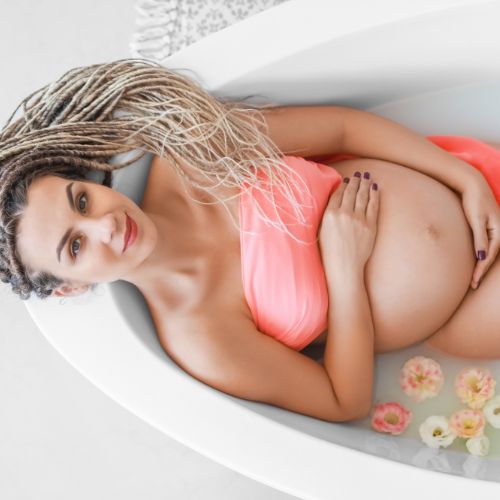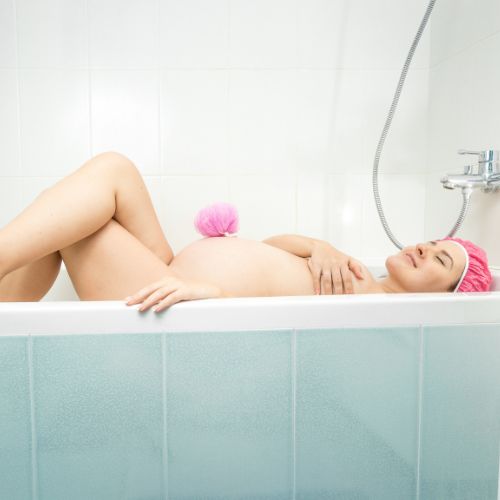Can a war bath help induce labor?
In order for spontaneous labor to occur, a few things need to happen. First there is a release of oxytocin which causes contractions. Your body will also release prostaglandins, which soften and thin the cervix. Baby will also move lower in the pelvis, and put pressure against the cervix which helps it to dilate.
Unfortunately, nothing in a warm bath will do that for your body. Wouldn’t it be great if it did?!
While I’ve heard some people say that raising your core body temperature can help induce labor, but unfortunately that’s not true. While core body temperature does increase during labor, it appears that it goes up as you progress through the stages of labor, not that it’s the rise in body temperature that causes labor (source).
Therefore, the answer to the question “does a hot bath induce labor?” is no, it doesn’t.

Disclaimer: this website does not offer medical advice. If you are concerned for your health and wellbeing, please consult with your personal healthcare provider. This website may contain affiliate links, meaning if a purchase is made using links on this page, I may earn a small commission at no additional cost to you.
Are baths safe during pregnancy?
During pregnancy you should make sure the water is at a safe temperature. You should avoid going in a hot tub and instead opt for baths that are warm to the tough.
This can be soothing on your aching body and can offer pain management through the labor process. Many expectant mothers choose to sit in warm water or stand in a shower during active labor to help with the pain of uterine contractions. This can be especially helpful for back labor as well.
Pregnancy bath products
Adding epsom salt and/or essential oils to the water is a good way to relax. Epsom salts contain magnesium which can help with muscle cramps and possibly morning sickness (like these ones from Pink Stork.)
Bubble baths, bath salts and bath bombs can feel luxurious and comforting towards the end of your pregnancy. Whatever bath products help you relax are usually OK!
Using a warm shower or bath can offer some respite from the pregnancy aches and pains. A nice warm bath is the best way to relax after a long day on your feet!
There are many anecdotal stories about things that can help induce labor. I get it – the end of pregnancy is tough! As your due date approaches, your excitement for your new baby may be mixed with anxious feelings as you wait for labor to start.
Labor induction
There are some medical reasons that your healthcare provider may recommend inducing labor, but sometimes you just feel done with being pregnant and ready for your baby’s birth. If you have a medical condition where induction is suggested, I would definitely recommend being induced at the hospital. There they can check on your and your baby to make sure the induction is tolerated well.
There are some natural ways you may be able to help start labor, however be careful as some of them can cause extra discomfort without actually starting labor. Never try to start labor without first speaking to your health care provider.

Natural ways to induce labor
There is mostly anecdotal data to support these. What that means is there are lots of stories from pregnant women saying these worked for them, but not a whole lot of scientific evidence. Many refer to these as “old wives’ tale”.
Some people will try all of these things and only notice some Braxton Hicks contractions. Others may go into labor!
- Spicy foods. Some people say that after a spicy meal they felt contractions start. Others have said that the stomach upset and diarrhea that can come with a spicy meal caused early labor to start.
- Castor oil. In many cultures, consuming castor oil is how natural labor induction is done. Be warned: castor oil is a powerful laxative and can cause nausea, vomiting and diarrhea. This method is not recommended if you have high blood pressure.
- Nipple stimulation. This is a great way to move labor along as it causes your body to release oxytocin. Breast stimulation can be done manually or with a breast pump.
- Evening primrose oil. Thought to be great for cervical ripening, these capsules have been studied orally and vaginally.
- Sexual intercourse. Reaching an orgasm has been thought to start contractions. In addition, male semen has prostaglandins which may help soften the cervix.
- Raspberry Leaf tea. Many people swear by drinking a few cups per day in the third trimester to “tone the uterus”. This is less to start labor but rather to make labor faster.
- Massage/acupressure. There is a thought that certain pressure points can start labor. A foot massage is an excellent way to relax at the end of pregnancy, but it’s not likely to start labor.
- Physical activity. Many people feel that after long days of walking or being on their feet, labor contractions start. This could be related to baby’s head putting pressure against the cervix.
- Birth balls. Bouncing on a birth ball may help baby get into a better position. It can also help keep your pelvis open and your joints and ligaments loose and relaxed. Birth balls are not likely to start labor, but can help it along.
- Membrane sweep. Your healthcare provider may offer a membrane sweep, where during a cervical exam the provider uses their finger to separate the bottom of the amniotic sac from the base of the uterine wall. This causes a release of prostaglandins that may start the birthing process. For some, this just causes discomfort and latent labor.
Medical induction of labor.
Certain medical conditions make pregnancy unsafe for either the pregnant person or their unborn baby. In some cases, you provider may recommend a labor induction. This is always a conversation to be had, and you should never feel forced or pressured into a labor induction.
There are different ways for a labor induction to start. The course of your induction typically depends on your cervical dilation. This can be checked with a vaginal exam.
Medical labor inductions typically start with prostaglandins. Prostaglandins are given orally or vaginally. The goal of these medications is cervical ripening, or thinning and softening of the cervix.
Some labor inductions use a synthetic version of the hormone oxytocin. Also called Pitocin or Syntocin, it is slowly increased until contractions are strong and close together.
If a warm bath is soothing to you, go ahead and take one! But don’t expect it to start labor…unfortunately it’s not that simple.

